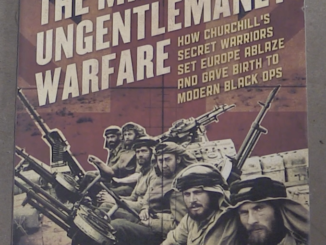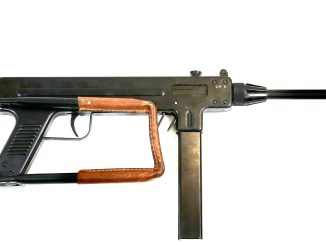When the Danish Coastal Police was formed under German occupation to patrol the Danish shores, they needed rifles. Rather than use valuable military arms, the government turned to the noted sporting and target rifle manufacturer Schultz & Larsen to make a military version of the Model 36 target rifle. The new weapon was a bolt action chambered in the Danish 8x58R cartridge, with a 4-round magazine capacity.
Only about a thousand of these RPLT (State Police) rifles were made, making them a pretty scarce find today, especially in the original military configuration like this one.




It’s elegant. I like it!
Rear locking lugs!!!! Obviously this rifle will not be able to hit a barn door even if you were inside the barn.
I’m guessing that you are joking?
“Without a clear indication of the author’s intent, it is difficult or impossible to tell the difference between an expression of sincere extremism and a parody of extremism.” – Poe’s Law
Schulz & Larsen’s main business was very high end target rifles and target rifle barrels
For a long time, those target rifles were rear locking
I suspect the reason for the Krag-type magazine was range safety with personnel who might not be too familiar with firearms generally.
By loading four rounds “through the bottom” it eliminated the typical “round in the chamber” accident that can occur with Mauser=type magazines which load through the action. The rifle was probably kept in Condition Three (chamber empty, magazine loaded) until needed.
cheers
eon
I also think this happened since Krag-Jorgensen rifles were the primary service rifles for Denmark at the time (in fact, they were used just when the Germans crossed the border on April 9th, 1940). So if the contractor making the rifles was used to fixing Krags for both soldiers and hunters, why bother telling him to switch to a charger-fed box magazine?
Trapdoor magazines can be topped off without having the bolt open, so the user of such a rifle still has at least one round on tap if he remembered how many shots were fired. But the loading procedure seems a bit fiddly.
1. Turn the rifle upside-down or on its side if possible
2. Open the magazine
3. Get cartridges from your ammunition pouch
4. Feed rounds into the magazine one at a time
5. Close magazine and ready weapon
6. If you cycled the bolt once to load, you may repeat steps 1-5 to top off
7. Target acquired! SHOOT! SHOOT!
Did I mess up the loading procedure?
“(…)loading procedure(…)”
For different fixed magazine fire-arm loaded from bottom see Soviet PTRS.
It is worth pointing out that the vast majority of Danish Jews were aided by the Danes to escape to Sweden in 1943. It seems that this unit most likely didn’t do it’s job.
Perhaps the reason that the Coast Guard Police “failed” the job on purpose was to get revenge upon the German occupiers. Besides, if the guards deported the Jews, they’d literally get stabbed in the back by the resistance movement.
It was quite deliberate in all likelihood. They seem to have used a lot of their influence to stall Nazi persecution of the Jew’s and then when this wasn’t going to work anymore there was a lot of deliberate leaking of plans to the Jewish community and the resistance organised evacuation while at more diplomatic levels Sweden was prevailed upon to accept them which it did. It is even suggested that some Germans in Denmark were happy to turn a blind eye to it. This probably being partly because they saw no need to upset the Danes who were largely cooperative. While it still was an occupation the Danes surrendered to occupation early after a token defence and avoided intense animosity from the occupying Nazis. At least this is what I’ve read on it. Doubtless some collaboration occurred and doubtless some violent resistance and reprisals.
I just finished the book “Swansong” which is a collection of diary entries and published comments from various people during the war, ranging from private soldiers on both sides, to concentration camp prisoners to Hitler’s “last testament”.
As I recall, there were some comments towards the end from German Kriegsmarine personnel in Denmark who were calmly waiting around to be demobilized and repatriated, in contrast to the armed conflict between Germans and the indigenous population elsewhere. Relations appeared to be quite cordial.
Denmark was probebly the best posting that a german soldier could get. It was called the “Sahnefront” cream rront. At least on german diplomat leaked the plan of the round up of the jews to the danish. The danish even used there political influence at best as there could to prevent the few jews that get cached to do in the deatcamps. A shining point in the danish history.
I have a Schults and larsen danish rplt if interested email me at dpfreda206@yahoo.com